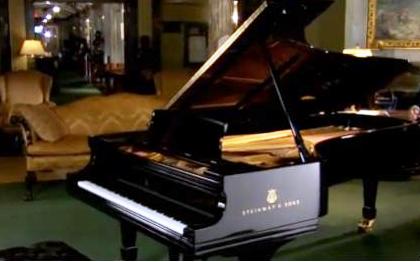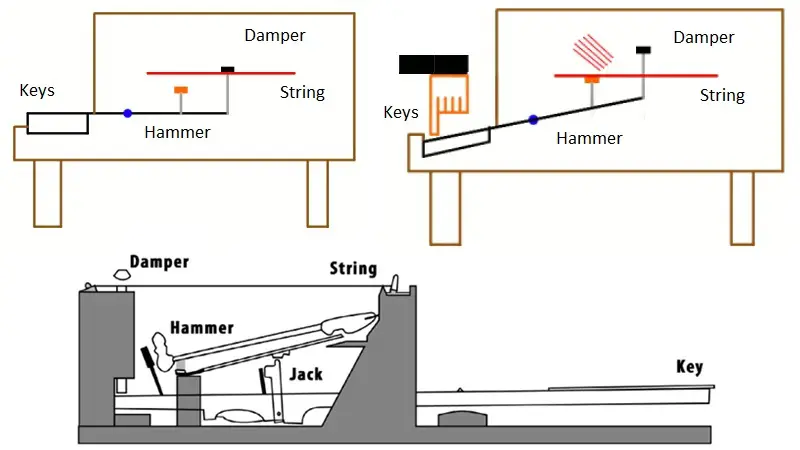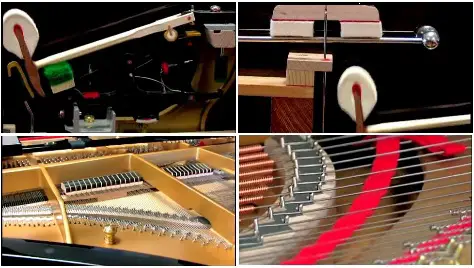
The various Parts of a Piano explained. Take a look at the various piano parts and components on an acoustic piano (to help you with maintenance, restoration and rebuilding). We also take a look at the construction of a digital piano/keyboard.
Parts of an Acoustic Grand Piano
An acoustic piano can have hundreds of moving parts; in fact if you look at the keys as different pieces, then that itself comes to 88 pieces, and then there are many more parts. We have already seen how acoustic pianos work. Here we will look at the various piano parts.

The basic parts of the Piano Action includes the 88 weighted keys, the various hammers and the wire strings. These parts go through the maximum wear and tear as these are moving parts. They form a part of what is known as the piano action, which is one of the key factors that decide how good the piano is.
Does it all look simple — the various parts of a Grand Piano? Even if it seems so, it is actually a complex mechanism that involves so many piano parts, especially if its an acoustic grand piano.
- Frame: Supports the Piano Strings
- Strings: Produces the sound. Treble strings are thinner. Bass strings are thicker
- Pinblock: Embedded in holes in the pinblock are steel tuning pins, around each of which is coiled one end of a piano string
- Hammers: These Hammers striking the string produces sound
- Soundboard: Amplifies the sound generated by the vibrating String
Here are the common parts of an acoustic grand piano.
Strings
Each key on a piano has one, two or three strings which are made of metals. The sound in a Piano is produced by a mechanism in which hammers strike these strings. Keys that produce lower sounds i.e. keys in the lower octaves have fewer strings and the strings are longer and thicker. The keys on the higher octaves, that produce higher sounds, have more strings and those strings are shorter and thinner.
A grand piano is where you have the strings parallel to the floor, as opposed to the vertical ones on the upright ones. The horizontal strings on a grand piano makes the sound waves travel up in the air and makes it easier to propagate the entire room. That is the reason a grand piano sounds louder and much better than any of the other types of pianos.
To get a better glimpse of the inside, just open the lid of any piano and you’ll see that in the inside each of the keys attach to hammers that strike the appropriate strings, when the keys are pressed.

Cast-Iron frame
The strings in a grand piano are stretched across a heavy cast iron plate, and underneath that you have the soundboard. This, along with the piano action, forms the crux of the piano.
This frame holds all the strings together and provides the required tension in all the strings. These frames are very strong, especially in the case of grand pianos, since the strings are parallel to the ground. These strong frames also ensure that the strings stay in tune for a longer period of time.
When a key is pressed, the hammer strikes the strings and the string vibrates, which in turn makes the entire soundboard/cast iron plate vibrate and the sound is produced.
The cast iron/soundboard is set on a foundation which forms the rim of the piano.
Soundboard
This is one of the most important parts of a Piano. The soundboard is a large piece of wood that amplifies the sound produced. On a grand piano, it is the piece of wood that sits at the bottom of the piano and on an upright piano it is at the back of the piano.
Damage to the soundboard will adversely affect the sound produced and can be very expensive to fix.
Dampers
Their function is to stop the strings from vibrating. Dampers are usually made of wood and the part of the damper that rests on the strings is covered with felt. In the normal position, dampers rests on the strings but when you press a key, the damper for that key lifts off allowing the strings to vibrate and produce sound. When you release the key the damper again sits on the strings and stops the stings from vibrating.
Hammers
Every key on a Piano is connected to a hammer and that is what strikes the strings when you press a key. The strings in turn vibrate to produce a sound. The hammers are usually made of wood.
Remember it’s a pianoforte.
You need to remember that a piano is basically a “pianoforte” and that means it has the ability to play the notes softy as well as loudly. So the hammer mechanism is built such that the hammers strike the keys harder when you press the keys harder, and softer when you play the keys softly.
Action
This is actually not one component and it refers to the feel of the mechanism that sets of inside a piano when you press a key. It consists of all the moving parts that work together to produce a sound. The heavier the action, the heavier the keys and the more force you need to apply to press the keys.
Parts of a Digital Piano Keyboard
A digital piano/keyboard uses electronics to mimic the working of an acoustic piano.
Keys / Keyboard
This is your keyboard section and will come with your desired number of keys and key action.
In case of a digital piano, the keys make contact with a sensor, which detects which key has been pressed, and how hard. Depending on that the right sound is produced (selected from the built-in samples).
The keys can be unweighted or fully weighted (to closely mimic the keys on a real piano).
The more expensive the instrument is, the more fine tuning is required to get this part as close as possible to the keys on a real piano.
The User Control
This is the user area were you have all the buttons, knobs, and slides arranged. You can use it to make all the selections, or make all the changes or do all the recordings (in case your keyboard has that feature).
You’ll also find a small screen, known as the LCD display, which shows all the selections, the music notations, lyrics and so on. You’ll also find built-in speakers.
Various Inputs / Outputs
Besides the keys and the pedals, on most digital pianos, you will find several inputs and outputs that are used to connect with external digital devices, including a computer/laptop.
On acoustic pianos, a cast iron frame supports the strings and sits above the soundboard. On digital pianos, it is usually the main-board and the chips that store the sound-bank.
Other Bundled parts
Depending on the offer, the dealer might also throw in things like stand, bags, power adapter. These are necessary accessories to get the most out of your keyboard.
The pedals
This is another prominent feature of any piano, the pedals. On acoustic pianos, you’ll see three of them, but most digital piano have just a couple of them.
The one on the right is the sustain pedal, that sustains any notes.
The other one is used to make the notes sound softer.
On most uprights, the pedals already exists, but then if it’s a digital piano, you can always buy them separately and connect it to your piano.
As a beginner, usually, you don’t get to use the pedals in the first few months at least, but it depends on your teacher as well.
So in the list of the piano keyboard parts names, the pedals also feature in prominently. These come inbuilt in the real acoustic pianos, but may not be available in the digital versions. You have to buy them separately as accessories.
Usually, most keyboard payers go in for the single pedal accessory, but then three-pedal units, which look similar to the ones on real piano, are also available.
KeytarHQ editorial team includes musicians who write and review products for pianists, keyboardists, guitarists & other musicians. KeytarHQ is the best online resource for information on keyboards, pianos, synths, keytars, guitars and music gear for musicians of all abilities, ages and interests.



Leave a Reply